The term the “Internet of Things” has been widely circulated in the media, yet the “Internet of Skills” is a relatively new concept. The Internet of Skills is “where 5G, AI and robotics meet,” according to Mischa Dohler, Professor in Wireless Communications at King’s College London and leading scientist in the field of digitalizing physical abilities. The Internet of Skills is a haptic information transfer, as opposed to a simple audio and visual knowledge transfer through platforms like the internet. Using robotics, haptic (or sensory) expertise can be taught and transferred to any location around the world in real-time. This enables remote surgeries, remote maintenance services, remote art lessons, and other physical training and learning.
In order to bring the internet skills to life, users need robotic tools, communication technology, and artificial intelligence (AI) systems to share data between the input source and destination. In more concrete terms, a person in the US could perform surgery on another person in Europe in real-time. Or a piano teacher in Sydney could teach an aspiring student in Tokyo how to play the piano, utilizing a robotic glove that records the teacher’s movement on the piano’s keys and transmits this data to the student, who is wearing an exoskeleton glove on their hands. This exoskeleton gently pushes the fingers on the piano keys, as recorded by the teacher, until the student’s muscle memory is trained. Remote surgeries or technical services (construction, repair, or maintenance) can be performed in a similar fashion, with an expert carrying out the motions and another person receiving this tactile information for training or real situations.
The internet of skills commonly requires three components: a visual, an audio, and a haptic component. The visual component is the capturing of 3D input and relies on virtual reality (VR) headsets. The audio component requires high-quality spatial microphones that capture the sound field in a room or space. The haptic component consists of wearable devices that record and perform motions. Haptic communication typically requires a very low latency of 1-10ms in order to transfer sensory information instantly with minimal delay. Such high-frequency haptic input and 3D visual information demand cloud technology and high network bandwidth (i.e. fast internet) for data delivery. This is where 5G will become indispensable. At present, 3G and 4G networks are the most common. Yet as 5G networks are installed around the globe, network speed will increase immensely. This is because 5G networks transmit data 100 times faster than 4G networks. Without 5G, the Internet of Skills will have no base to build upon because fast communication speed is crucial. Furthermore, AI systems supplement this connection by predicting movement at the input location (e.g. the expert surgeon) and granting the signal enough time to reach its destination (e.g. medical student, medical staff, or machine).

This technological innovation can improve life in various ways. For instance, the Internet of Skills allows people to work and train remotely without the need to travel for business. This could potentially reduce air traffic and greenhouse gas emissions. It can also grant access to high-quality training to people in developing countries that may not have access to such education. Furthermore, it enables remote surgeries in disaster areas. Much like the internet gave humans access to a free flow of information, the internet of skills may grant people access to a more globalized flow of education and services.
While the opportunities are promising, the Internet of Skills also entails risks. Lives, labor, and services will become highly dependent on a stable and fast internet connection. Installing 5G in developed countries may be relatively easy, yet developing countries with remote villages and locations that have no access to a stable source of electricity will be automatically excluded from this opportunity, perpetuating global inequality.
Another risk is that, in some countries, internet connections are controlled by state governments which arbitrarily impose internet blackouts for political purposes, such as to stifle the freedom of speech and civil dissent. Countries like India, Iraq, or Morocco have struggled with government control over the internet. Government-mandated internet shutdowns may affect only social media, but could potentially reach the entire internet network in a country. This could be highly critical if internet-of-skills technology is utilized while the internet is being shut down, leaving the data source and data receptor disconnected and operations unfinished. In the most extreme cases, for instance, surgery, this can cost human life.
In conclusion, the Internet of Skills can advance the United Nations Sustainable Development Goals by reducing the carbon footprint. Despite this positive outlook, however, three factors must be taken into account in the course of the next decade as the technology for the Internet of Skills is developed and refined. First, international security standards for such remote operations must be established. Second, since the Internet of Skills is extremely dependent on stable internet networks, internet blackouts or other connection interferences pose a high risk to operations. Third, developed countries are more likely to be able to utilize the Internet of Skills technology than developing countries with lacking electricity and internet networks. In sum, the Internet of Skills may provide as many opportunities as it does risks.
